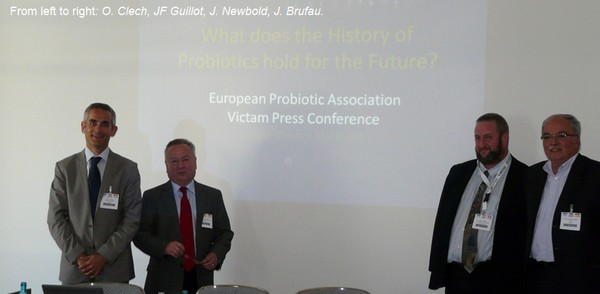Probiotics in animal nutrition, today and tomorrow: the experts’ opinion
Published: May 30, 2011
By: European Probiotic Association (EPA)
To mark the creation of its Scientific Committee, the European Probiotic Association (EPA) held a conference during VICTAM International 2011 in Cologne, in order to discuss the place of probiotics as feed additives, and the opportunities they offer for tomorrow's sustainable and profitable animal production. This event was the opportunity for members of the press and representatives of the probiotic industry to meet and share with some of the scientific experts.
The EPA VICTAM event was dedicated to the memory of Bruno Rochet, former Chairman of EPA since it was funded in 1999.
The meeting was introduced by Mr Olivier Clech, EPA Chairman, who reminded the audience about the organisation's missions and presented the Scientific Committee and its key role:
- to Support EPA communication and education activities about the benefits and applications of probiotics in animal nutrition,
- to advise EPA on future directions and opportunities for probiotics development,
- to act as jury panel for the Jules Tournut Award.
Members of the Scientific Committee are:
- Prof. Jean-François Guillot from Université de Tours in France,
- Prof. Joaquim Brufau from IRTA (Institut de Recerca i Tecnologia Agroalimentàries) in Spain, - Prof. Jamie Newbold from Aberystwyth University, in Wales,
- Dr François-Joël Gatesoupe, from INRA (Institut National de la Recherche Agronomique) and Ifremer (Institut français de recherche pour l'exploitation de la mer).
Here is a brief overview of the key topics discussed in Cologne.
How and why do probiotics work?
 Today, the efficacy of probiotics* in animal feed is widely accepted. In Europe, all registered products have had to prove their efficacy with several controlled field trials under various production conditions. According to Professor Guillot, a microbiologist who has been involved in probiotic applications since the early days, if we know that probiotics work we are still not sure of how they actually work. According to him, there are many suggested modes of action, but only a few are scientifically demonstrated. He is convinced that "a better understanding of probiotics modes of action is crucial for the development of new products". An answer for this could come from the rapid evolution of molecular biology technologies. Indeed, in his presentation about elucidating some of live yeast modes of action in the rumen using advanced molecular biology technologies, Professor James Newbold explains us why he thinks that "now is a very exciting time for probiotics: for the first time we have the tools to see how they actually work". For example, powerful gene sequencing technologies helped him study in details digestive microbial populations in the rumen and how they are affected by the administration of probiotic yeast. Professor Newbold also stressed out the fact that what is demonstrated for one particular strain of yeast is not necessarily true for another, the same being true for bacteria, an important feature of probiotics known as strain specificity.
Today, the efficacy of probiotics* in animal feed is widely accepted. In Europe, all registered products have had to prove their efficacy with several controlled field trials under various production conditions. According to Professor Guillot, a microbiologist who has been involved in probiotic applications since the early days, if we know that probiotics work we are still not sure of how they actually work. According to him, there are many suggested modes of action, but only a few are scientifically demonstrated. He is convinced that "a better understanding of probiotics modes of action is crucial for the development of new products". An answer for this could come from the rapid evolution of molecular biology technologies. Indeed, in his presentation about elucidating some of live yeast modes of action in the rumen using advanced molecular biology technologies, Professor James Newbold explains us why he thinks that "now is a very exciting time for probiotics: for the first time we have the tools to see how they actually work". For example, powerful gene sequencing technologies helped him study in details digestive microbial populations in the rumen and how they are affected by the administration of probiotic yeast. Professor Newbold also stressed out the fact that what is demonstrated for one particular strain of yeast is not necessarily true for another, the same being true for bacteria, an important feature of probiotics known as strain specificity.When and how to use probiotics?
 According to Professor Newbold, "if we understand how a probiotic work, we can know better when it works best, in which conditions." What is sure, is that probiotics, unlike endogenous bacteria, do not multiply in the gut, and continuous supply is necessary.
According to Professor Newbold, "if we understand how a probiotic work, we can know better when it works best, in which conditions." What is sure, is that probiotics, unlike endogenous bacteria, do not multiply in the gut, and continuous supply is necessary.In the case of pigs and poultry, Professor Guillot suggests that "a dose of 106 to 107 CFU/g of feed administered continuously is necessary to obtain a balance in the gut between probiotic microorganisms and bacteria of the resident microflora." Because of their mode of action, probiotics effects are not immediate. For example, when Professor Newbold looked at the effects probiotic yeast had on rumen microbial populations, he says that it takes one to two weeks to be able to observe any changes.
In all animal species, it is particularly recommended to use probiotics at time of important stress and demand on the animal metabolism such as transportation, weaning, dietary changes, pregnancy, farrowing, lactation... In aquaculture, where probiotics are increasingly used for zootechnical and sanitary benefits, Professor Gatesoupe suggests that "early development stages are generally the most sensitive to bacterial infection, until the maturation of the immune system, and may be an optimal period for probiotics. However, the duration of the treatments should be deeply investigated, and there may be other critical periods which would require particular attention, for example to prevent seasonal diseases, or during later ontogenic steps like smoltification in salmonids."
Probiotics are regulated feed additives
 Professor Brufau, from IRTA, in Spain, gave an update about feed additives European regulation and how probiotics stand in the current regulation. Indeed, since 1996, micro-organisms (probiotics but also silage inoculants), are considered as feed additives and producers must document their identity, safety and efficacy for the target species (Regulation (EC) No 1831/2003). As Professor Brufau pointed out: "the EU registration is a time consuming process which requests loads of documentation and involves heavy dossiers". But it is the guarantee for users of a product efficacy, safety and quality.
Professor Brufau, from IRTA, in Spain, gave an update about feed additives European regulation and how probiotics stand in the current regulation. Indeed, since 1996, micro-organisms (probiotics but also silage inoculants), are considered as feed additives and producers must document their identity, safety and efficacy for the target species (Regulation (EC) No 1831/2003). As Professor Brufau pointed out: "the EU registration is a time consuming process which requests loads of documentation and involves heavy dossiers". But it is the guarantee for users of a product efficacy, safety and quality.2008 has seen an important and positive evolution of the regulation with the introduction of 'functional groups': feed additives are classified according to their function, not their composition. For example, under this regulation, probiotics are usually classified as 'Gut Flora stabilisers'. This new regulation has been welcomed by the industry since it allows to link functionality claims to a product.
Beyond the gut...
If today probiotics belong to the 'Gut Flora stabilisers' functional group, one can very well imagine that in the future, various functionality, thus claims, could be officially attributed to probiotics once the appropriate dossiers are constituted, such as for example welfare claims. Probiotics have now been used for 25-30 years in animal production and their effects and potential do not stop at gut's health: this has been observed by many users and scientific data start to back this up. Scientists have shown for example the benefits of certain probiotics in enhancing immunity or reducing the effects of stress...
When questioned about what they foresee for the future of probiotics, the experts agreed on several promising directions such as animal welfare, a virgin territory of growing needs, but also environmental issues, as well as end products quality. For example, some strains have shown qualitative and sanitary effects on food products, such as improved egg quality, reduction of salmonella carriage on chicken, meat quality etc.
So, to quote Bruno Rochet six years ago during EPA scientific seminar in Rome, more and more professionals are convinced that 'the future is bright for probiotics', and they certainly have an important role to play in tomorrows' sustainable agriculture....
For more information, do not hesitate to contact us for a full media pack of VICTAM press conference or high-quality versions of the pictures.

* According to Roy Fuller's definition (1989), probiotics are " live microbial feed supplement which beneficially affects the host animal by improving its intestinal microbial balance". This definition poses the main conditions for a product to be qualified as probiotic. In other words, it must contain microorganisms (either bacteria or yeast) which are alive (probiotic quantification is expressed as CFU, which represents the number of LIVING microorganisms), and exert a proven benefit on the target species. Probiotics commonly used in animal feed are mainly Gram-positive bacteria belonging to the types Bacillus, Enterococcus, Lactobacillus or Pediococcus, and certain yeast strains from the Saccharomyces cerevisiae species in particular (S. boulardii).
Source
European Probiotic Association (EPA)Related topics:
Authors:
Lallemand
Recommend
Comment
Share

Would you like to discuss another topic? Create a new post to engage with experts in the community.






